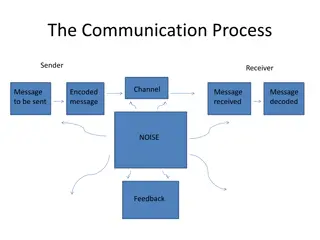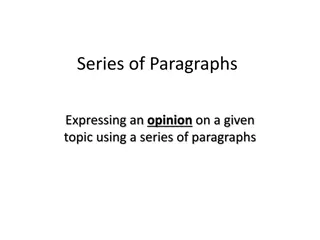The Art of Communication: Expressing Yourself Effectively
Exploring the essence of communication, this content delves into various aspects such as different ways to communicate, interpreting quotes on communication, understanding cultural communication methods, and the significance of effective communication strategies. Readers are invited to reflect on personal interpretations, implications of varied communication styles, and the role of nonverbal cues in conveying messages across diverse cultures.
Download Presentation

Please find below an Image/Link to download the presentation.
The content on the website is provided AS IS for your information and personal use only. It may not be sold, licensed, or shared on other websites without obtaining consent from the author. Download presentation by click this link. If you encounter any issues during the download, it is possible that the publisher has removed the file from their server.
E N D
Presentation Transcript
Unit #4: Express Yourself EQ: What Does It Really Mean to Communicate?
What are different ways to communicate? List 5 way to communicate in order of their effectiveness. 5- (most effective): 4- (very effective): 3- (moderately effective): 2- (less effective): 1- (not very effective):
What do these quotes mean? Words can be bullets or butterflies. The truth uplifts, while lies destroy. -Piri Thomas Only talk when it improves the silence. -Chris Matthews
What do the quotes mean to you? Do you agree/disagree with the quotes? Why? Which applies to your life? Explain!!!
How do different cultures communicate?
In your own words, what does it really mean to communicate?
Reading Strategy: Ask Questions Ask the Text Who? Where? Why? What? When? How? What does this remind me of? What do I already know about this? What can I predict from what I ve read so far? Do I agree with this? What are you saying or implying here? What s your main point? Ask Yourself Ask the Author
Nonfiction Text Structures: Text Structure Purpose Signal Words Visual Representation Cause & Effect To show how something happened or came to be the way it is As a result if/then Because Therefore consequently Since Cause Effect Problem & Solution If Then or If A Then B or C To show how a problem or issue can be solved Examples For example That is For instance I. Main Idea A. Example 1 B. Example 2 To illustrate or describe examples of a particular main idea, or thesis Chronological Order Afterward next meanwhile then Not long after Following First Next Then Later To show the time order or sequence of events later
Cluster #1 Face Facts: The Science of Facial Expressions What do you think? 1. Words are the best way to communicate. Agree or Disagree 2. You cannot tell what someone is thinking by looking at him or her. 3. What we communicate is not as important as how we communicate
Look at the girls on pg.353 and describe the girl s expression.
Facial Expressions My Question My Answer 1. Is it possible to fake a smile? 2. Who is Paul Ekman? 3.What are Ekman s accomplishments? Or Why is Ekman s work important?
Global Expressions 4. What are the seven universal facial expression categories? 5. What are microexpressions ? 6. How are the facial expressions for _____________ and ____________________ similar or different?
Expressional Analysis 7. What situation could result if a police officer doesn t notice that a suspect is lying? 8. Why is it so difficult to be a wizard at catching liars? 9. What careers benefit from a person s ability to detect liars?
Cluster #2 Goals & Objectives: They Speak for Success Literary Analysis Objective: Analyze Examples Reading Strategy Objective: Ask Questions: Find Question-Answer Relationships
Remember when Write about a time when it was hard for you to speak to person or group of people. (Use imagery to describe the incident)
My Question Pg. # What I Already Know What the Author Tells Me (examples) My Answer: How It Fits Together (Synthesis)























